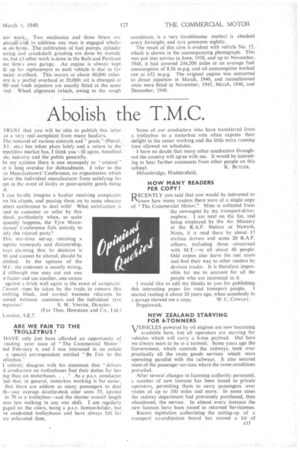Abolish the TUC.
Page 21

Page 22

If you've noticed an error in this article please click here to report it so we can fix it.
TRUST that you will be:able to publish this letter as a very real. complaint from many hauliers. The removal of various controls and "pools." (Petrol, etc.) has taken place' lately' and a return to the mpetitive market has, I think you 1.111 agree, benefited de, industry and the public generally.
In my opinion there is one monopoly or " control " it is long overdue for disbandment. I refer to the re Manufacturers' Conference, an organization which ieves the individual manufacturer from satisfying his ent in the event of faulty or poor-quality goods being d.
can hardly imagine a haulier receiving complaints ina his clients, and passing them on to some obscure tillers conference to deal with! What satisfaction is ned to customer or seller by this !thod; particularly when; as quite quently happens, the Tyre Mann:turers' Conference fails entirely to isfy the injured party?
This war-time set-up, retaining a mplete monopoly and dictatorship, vays claiming that its decision is ht and cannot be altered, should be olished. In the opinion of the N.4.C. the customer is usually wrong, d although one may cut out one .e factor and use another, one comes against a brick wall again in the event of complaint. Cannot steps be taken by the trade to remove this imbling block, and normal business relations be aimed between customers and the individual tyre mpanies? S. W. ViNTER, Director. (For Thos. Hewstone and Co., Ltd.) London, S.E.7.
ARE WE FAIR TO THE TROLLEYBUS?
HAVE only just been afforded an opportunity of reading your issue of "The Commercial Motor" ted February 4, and -I was interested in an article a special correspondent entitled "Be Fair to the ol fey b us."
I entirely disagree with his statement that "drivers d conductors on trolleybuses find their duties far less ing than on motorbuses. . . ." As a p.s.v. conductor ind that, in general, motorbus working is far easier, that there are seldom as many passengers to deal th—our average double-deck oiler seats 55, against to 70 in a trolleybus—and the shorter overall length Nans less walking in any one shift. I am regularly gaged on the oilers, being a p.s.v. licence-holder, but ve conducted trolleybuses and have always felt far are exhausted then. Some of our conductors who have transferred from a trolleybus to a motorbus rota often express their delight at the easier working and the little extra running time allowed on schedules.
I have no doubt that many other conductors throughout the country will agree with me. It would be interesting to hear further comments from other people on this
subject. K. BUTLER. Milnesbridge, Huddersfield.
HOW MANY READERS PER COPY?
RECENTLY you said that you would be interested to "know how many readers there were of a single copy of "The Commercial Motor." Mine is collected from the newsagent by my transport-driver nephew. I am next on the list, and being employed by the Air Ministry at the R.A.F. Station at Newark. Notts, it is read there by about 15 civilian drivers and some 20 R.A.F. officers, including those concerned with M.T.—in all about 40 people. Odd copies also leave the rest room and find their way to other readers by devious tracks. It is therefore impossible for me to account for all the people who are interested in it.
I would like to add my thanks to you for publishing this interesting paper for road transport people. I started reading it about 20 years ago, when somebody in a garage showed me a copy. W. C. COWLEY. Popplewick.
NEW ZEALAND STARVING FOR 6-TON N ERS VEHICLES powered by oil engines are now becoming v available here, but all operators are starving for vehicles which will carry a 6-ton payload. Out here we always seem to be in a turmoil. Some years ago the Government, which controls the railways, took over practically all the route goods services which were operating parallel with the railways. It also secured most of the passenger services where the same conditions prevailed.
After several changes in licensing authority personnel, a number of new licences has been issued to private operators, permitting them to carry passengers over routes of up to 100 miles and more. In some cases the railway department had previously purchased, then abandoned, the service. In almost every instance the new licences have been issued to returned Servicemen.
Recent legislation authorizing the setting-up of a transport co-ordination board has caused a lot of conttoversy. .Many leaders in the industry are of the opinion that it will never be made to 'function Properly: Of its 15 members, independent road transport operators are to have one representative for goods transport and one for passenger-service interests. Coastal shipping will have one representative and the remainder will be nominees from Government departments and trade union officials.
In fact; Our representatives are appointed by the Minister of .Transport. We hope• he will do so from nominations submitted by the Passenger Federation or the Road Transport Alliance.
With the exception of one province, all our carriers appear to be fairly 'busy. One of our troubles, however, is that distributors are taking delivery of vehicles which are unsuitable for our use. They are being Sold to farmers and other ancillary users who require no licence, because their operations are confined to routes within a distance of 30 miles parallel with the railways.
The result of this is that we are losing much of our return tonnage, and our price, schedule—based on the assumption that we get 25 per cent. of our running as return loads—is now completely out of balance. The Goods Services Price Tribunal has been instructed by the Cabinet that when revising a schedule; rates are Co be fixed on a basis which, whilst permitting the wheels 1O be kept turning, will not allow any commercial profit.
An effort isbeing , made • to have this instruction with
. drawn. As you may 'kriOW, however ; 'it takes many months to get a ,Government department to move'
In the meantime, the Drivers " .Union is endeavouring • •-; to obtain further large Wage increases .' In spite of all this, the independent operator stillmakes substantial contributions to the national fund by way of inCo'ine fix We are at present engaged in a minor war With -the. roads authorities over permissible maximum axle loads. '– lathe past these have been fairly satisfactory for districts with Class 111 roads, Which permit 54 tons for two-axled vehicles and 5 tons for multi-akled vehicles. There is a move, 'however; to have these roads regraded to Class IV, with a maximum axle load of 4. tons !and, In .. some places, to Class V,.permitting only 3-ton axle loads.
In those parts of the country where there are no rail facilities, this low loading capacity is goingto •
increase road freight charges to the extent that agricultural production will be retarded. We hauliers. claim that the general deterioration of the roads is due more to neglect than any other cause. Some authorities are not . using up-to-date methods of maintenance and construction. The arterial roads, however, which are now controlled by the. Main Highways Board, are steadily improving in standard and Maintenance.
J. T. G. SOMERVILLE, Assistant Manager(for South Otago Transport. Ltd.), Balclutha, New Zealand.
FACTORSIN TRAFFIC, •
IMPROVEMENT •
THERE have been suggestions that the only satisfai tory easing of the position concerning .-pedestria crossings would be 'to adjust the traffic lights so th they include a brief period of total red and, at th same time, illuminate the crossings with "Cross Now signals.
In Manchester there is a crossing at the junction c Market Street and High Street which works in this was have often wondered why it is not employed at rnor places. The only fault with this one seems to be Oro the illuminated sign is not large 'enough. It could b better situated, for it is dwarfed by the other signal and is difficult for the' stranger to observe_ There will, of course, still be pedestrians who wi race the lights and stand a foot or so off the kerbs v the corners, to dash across immediately the lights changt
Not long ago you wrote about the shortage of tram port cafes, and I am wondering where I could obtai some ,,information regarding the districts and road where these places are most needed, preferably in stretch of country district where it is possible to obtai land at a reasonable price, because it is an advantag to prOvidesittficient parking places off the road.
. Now 'that trams have been dispensed with i .t.lanchester, there is a big improvement, but one snat lins 'drivers seem to have a habit of clinging to the crOw, of the rciad, whilst, often, instead of pulling into th
kerb -passengers on and off, they stop a foot o two ,away„sometirnes with the front of the bus stickin out ready-IforA.quick moveoff. In certain district where thejovids are narrow, quite a few vehicles ar parked ',,at.=the sides of them, and this. action by bu drivers prevents other traffic from passing and cause jams: The buses also frequently run in Convoy, makin it impossible for other vehicles to risk overtaking o passing when two or three of them pull up togethei
StOckport. F. CLARKE.
[We agree that it is often difficult for passengers to see th r" Cross Now" notices, and this point might be accepte as one in favour of talking signals. The all-red perio seems to work Satisfactorily in some places, but it i inclined to slow traffic, As to where a transport caf Would be most suitable, we would leave this to some c the men concerned to answer—if they will. You wi have to remember that if you build a cafe on undevelope land, you will probably be affected by the Town an Country Planning Act, and be required to make a im.mediate payment for adding to the value of the are concerned.—Eo.]


























